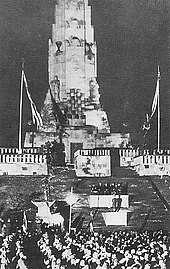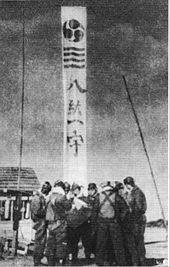| Revision as of 18:52, 22 September 2010 editBukubku (talk | contribs)2,327 edits Kita was executed in 1937. he is irrelavant.← Previous edit | Revision as of 21:54, 22 September 2010 edit undoFlying tiger (talk | contribs)Extended confirmed users2,871 edits Rv japanese imperialist propaganda by BukubkuNext edit → | ||
| Line 8: | Line 8: | ||
| Ambiguous in its original context, Tanaka interpreted the statement by Jimmu, mythically descended from the sun goddess ], as meaning that imperial rule had been divinely ordained to expand until it united the entire world. While Tanaka saw this outcome as resulting from the emperor's moral leadership, many of his followers were less pacifist in their outlook. | Ambiguous in its original context, Tanaka interpreted the statement by Jimmu, mythically descended from the sun goddess ], as meaning that imperial rule had been divinely ordained to expand until it united the entire world. While Tanaka saw this outcome as resulting from the emperor's moral leadership, many of his followers were less pacifist in their outlook. | ||
| == |
==Growing Expansionism== | ||
| {{See|Racial Equality Proposal, 1919|Jewish settlement in Imperial Japan}} | |||
| ]'s calligraphy of ''Hakkō ichiu'', carved on its front side.<ref>David C. Earhart, ''Certain Victory'', 2008, p. 63.</ref>]] | ]'s calligraphy of ''Hakkō ichiu'', carved on its front side.<ref>David C. Earhart, ''Certain Victory'', 2008, p. 63.</ref>]] | ||
| ] | ].]] | ||
| ] and ] presiding the celebration of the 2600th anniversary of mythical foundation of the Empire in November 1940.]] | ] and ] presiding the celebration of the 2600th anniversary of mythical foundation of the Empire in November 1940.]] | ||
| ].]] | |||
| Japanese in western nations suffered from ] issues as did other nonwhite races. In 1919, Japan proposed a ], at the ], the proposal got a majority but vetoed by the ]. In 1924, the ] was put in force. Then ] immigrated in ], however, ], ] was not recognized by the ]. On December 6, 1938, | |||
| Five ministers council (] ], ] ], ] ], ] ] and ] ]) which was the highest decision making council at the time,<ref name=mof>{{cite web | title=Question 戦前の日本における対ユダヤ人政策の基本をなしたと言われる「ユダヤ人対策要綱」に関する史料はありますか。また、同要綱に関する説明文はありますか。 | publisher = ] | url = http://www.mofa.go.jp/mofaj/annai/honsho/shiryo/qa/senzen_03.html |accessdate = 2010-09-21}}</ref><ref name=gosho>{{cite web | title=猶太人対策要綱 |work= Five ministers council | publisher = ] | url = http://www.jacar.go.jp/DAS/meta/listPhoto?IS_STYLE=default&ID=M2006092115064531921 |page= 36/42|date=1938-12-06 |accessdate = 2010-09-21}}</ref> made a decision of prohibiting the expulsion of the ] in ], ] and ] in accordance with the spirit of racial equality have insisted for many years.<ref name=mof/><ref name=gosho/> Then Japanese received ] against their alliance ] opposition. | |||
| Japanese in western nations suffered from ] issues as did other nonwhite races. In 1919, Japan proposed a ], at the ], but this measure was vetoed by the ]. With the economical crisis caused by the ], this led in the 1930s to a resurgence of ], ] and expansionism movements culminating in the ] and the ]. Radical nationalists such as ], proponent of ], and ] were quick to adopt the term ''Hakko Ichiu'', and to interpret it as meaning that the Japanese were a divine race destined to pacify the world, by force if necessary.<ref>Brendan, The Dark Valley, A Panorama of the 1930s, p. 43.</ref> | |||
| Emperor Shōwa and his reign became associated with the rediscovery of ''Hakkō ichiu'' as an expansionist element of Japanese nationalistic beliefs.<ref>Bix, Herbert. (2001). </ref> The naval limitations treaties of 1921, and especially 1930, were a mistake{{Clarify|date=August 2010}} in their unanticipated effect on internal political struggles in Japan; and the treaties provided an external motivating catalyst which provoked reactionary, militarist elements to desperate actions which eventually overwhelmed civilian and liberal elements in society.<ref>Morrison, Samuel Eliot. (1948). </ref> | |||
| The evolution of ''Hakkō ichiu'' serves as a changing litmus test of these factional relationships during the next decade.<ref>]: </ref> | The evolution of ''Hakkō ichiu'' serves as a changing litmus test of these factional relationships during the next decade.<ref>]: </ref> | ||
| Line 25: | Line 21: | ||
| The term ''Hakkō ichiu'' did not enter general circulation until 1940, when the second Konoe administration issued a ] titled “Fundamental National Policy” (] ''Kihon Kokusaku Yōkō''), which opened with these words, and in which Prime Minister Konoe proclaimed that the basic aim of Japan's national policy was "the establishment of world peace in conformity with the very spirit in which our nation was founded"<ref>Edwards, p. 309. <br>In the original text,「肇国の大精神に基き世界平和の確立を招来すること」.</ref> and that the first step was the proclamation of a "new order in East Asia" (] ''Tōa Shin Chitsujo''), which later took the form of the "]"). | The term ''Hakkō ichiu'' did not enter general circulation until 1940, when the second Konoe administration issued a ] titled “Fundamental National Policy” (] ''Kihon Kokusaku Yōkō''), which opened with these words, and in which Prime Minister Konoe proclaimed that the basic aim of Japan's national policy was "the establishment of world peace in conformity with the very spirit in which our nation was founded"<ref>Edwards, p. 309. <br>In the original text,「肇国の大精神に基き世界平和の確立を招来すること」.</ref> and that the first step was the proclamation of a "new order in East Asia" (] ''Tōa Shin Chitsujo''), which later took the form of the "]"). | ||
| == |
==Holy war== | ||
| As the ] dragged on without conclusion, the Japanese government turned increasingly to the nation's spiritual capital to maintain fighting spirit. | As the ] dragged on without conclusion, the Japanese government turned increasingly to the nation's spiritual capital to maintain fighting spirit. | ||
| Line 45: | Line 41: | ||
| * ] | * ] | ||
| * ] | * ] | ||
| * ] |
* ] | ||
| * ] | * ] | ||
Revision as of 21:54, 22 September 2010

Hakkō ichiu (八紘一宇, literally "eight cords, one roof" i.e. "all the world under one roof") was a Japanese political slogan that became popular from Second Sino-Japanese War to World War II, and was popularized in a speech by Prime Minister of Japan Fumimaro Konoe on January 8, 1940.
Outline
The term was coined early in the twentieth century by Nichiren sect Buddhist activist and ultranationalist Tanaka Chigaku, who cobbled it from parts of a statement attributed in the chronicle Nihon shoki to legendary first emperor Jimmu at the time of his ascension.
Ambiguous in its original context, Tanaka interpreted the statement by Jimmu, mythically descended from the sun goddess Amaterasu, as meaning that imperial rule had been divinely ordained to expand until it united the entire world. While Tanaka saw this outcome as resulting from the emperor's moral leadership, many of his followers were less pacifist in their outlook.
Growing Expansionism



Japanese in western nations suffered from racial discrimination issues as did other nonwhite races. In 1919, Japan proposed a racial equality clause, at the Paris Peace Conference, but this measure was vetoed by the Great Powers. With the economical crisis caused by the Great Depression, this led in the 1930s to a resurgence of ultranationalism, militarism and expansionism movements culminating in the May 15th Incident and the February 26 Incident. Radical nationalists such as Ikki Kita, proponent of Shōwa Restoration, and Sadao Araki were quick to adopt the term Hakko Ichiu, and to interpret it as meaning that the Japanese were a divine race destined to pacify the world, by force if necessary.
Emperor Shōwa and his reign became associated with the rediscovery of Hakkō ichiu as an expansionist element of Japanese nationalistic beliefs. The naval limitations treaties of 1921, and especially 1930, were a mistake in their unanticipated effect on internal political struggles in Japan; and the treaties provided an external motivating catalyst which provoked reactionary, militarist elements to desperate actions which eventually overwhelmed civilian and liberal elements in society.
The evolution of Hakkō ichiu serves as a changing litmus test of these factional relationships during the next decade.
The term Hakkō ichiu did not enter general circulation until 1940, when the second Konoe administration issued a white paper titled “Fundamental National Policy” (基本国策要綱 Kihon Kokusaku Yōkō), which opened with these words, and in which Prime Minister Konoe proclaimed that the basic aim of Japan's national policy was "the establishment of world peace in conformity with the very spirit in which our nation was founded" and that the first step was the proclamation of a "new order in East Asia" (東亜新秩序 Tōa Shin Chitsujo), which later took the form of the "Greater East Asia Co-Prosperity Sphere").
Holy war
As the Second Sino-Japanese War dragged on without conclusion, the Japanese government turned increasingly to the nation's spiritual capital to maintain fighting spirit.
Characterization of the fighting as a "holy war" (聖戦 seisen), similarly grounding the current conflict in the nation's sacred beginnings, became increasingly evident in the Japanese press at this time. In 1940, a League of Diet Members Believing the Objectives of the Holy War was launched to provide political support to Japan's goals in its war in China.
The general spread of the term Hakkō ichiu, neatly encapsulating this view of expansion as mandated in Japan's divine origin, was further propelled by preparations for celebrating the 2600 anniversary of Jimmu's ascension, which fell in the year 1940 according to the traditional chronology.
Allied response
After Japan declared war on the Allies in December 1941, Allied governments produced several propaganda films citing the Hakkō ichiu as evidence that the Japanese intended to conquer the entire world.
The official translation offered by contemporary leaders was "universal brotherhood", but it was widely acknowledged that that expression meant that the Japanese were "equal to the Caucasians but, to the peoples of Asia, we act as their leader."
See also
- Racial Equality Proposal, 1919
- Greater East Asia Conference
- An Investigation of Global Policy with the Yamato Race as Nucleus
- Shinmin no Michi
- Uyoku dantai
- Japanese militarism
- Japanese nationalism
- Statism in Shōwa Japan
- Lebensraum
Notes
- Beasley, Japanese Imperialism 1894–1945, pp. 226–7.
- As early as 1928, the Japanese editorials were already preaching the theme of the hakko ichiu without using the specific term. Michio Nakajima, Tennō no daigawari to kokumin, Aoki Shoten 1990, pp. 129–30.
- David C. Earhart, Certain Victory, 2008, p. 63.
- Brendan, The Dark Valley, A Panorama of the 1930s, p. 43.
- Bix, Herbert. (2001). Hirohito and the Making of Modern Japan, p. 201.
- Morrison, Samuel Eliot. (1948). History of United States Naval Operations in World War II: The Battle of the Atlantic, September 1939 – May 1943, pp. 3–10.
- GlobalSecurity.org: "Kodo (Way of the Emperor)"
- Edwards, p. 309.
In the original text,「肇国の大精神に基き世界平和の確立を招来すること」. - Stephen S. Large. Shōwa Japan. New York: Taylor & Francis, 1998. p. 202.
References
- Beasley, William G. (1991). Japanese Imperialism 1894–1945. Oxford: Oxford University. 10-ISBN 0-198-22168-1; 13-ISBN 978-0-198-22168-5.
- Bix, Herbert P. (2001). Hirohito and the Making of Modern Japan. New York: HarperCollins. 10-ISBN 0-060-93130-2; 13-ISBN 978-0-060-93130-8.
- Brendon, Piers (2002). The Dark Valley: A Panorama of the 1930s. New York: Vintage. 10-ISBN 0-375-70808-1; 13-ISBN 978-0-375-70808-4.
- Brownlee, John (1997). Japanese Historians and the National Myths, 1600-1945: The Age of the Gods. Vancouver: University of British Columbia Press. ISBN 0774806451.
- Earhart, David C. (2007). Certain Victory: Images of World War II in the Japanese Media. Armonk, New York: M.E. Sharpe. 10-ISBN 0-765-61776-5; 13-ISBN 978-0-765-61776-7.
- Edwards, Walter. "Forging Tradition for a Holy War: The Hakkō Ichiu Tower in Miyazaki and Japanese Wartime Ideology." Journal of Japanese Studies 29:2 (2003).
- Morrison, Samuel Eliot (1948). History of United States Naval Operations in World War II: The Battle of the Atlantic, September 1939 – May 1943. Oxford: Oxford University Press. 40 editions — .
